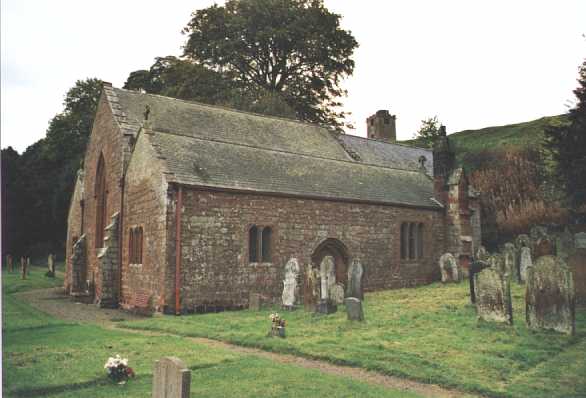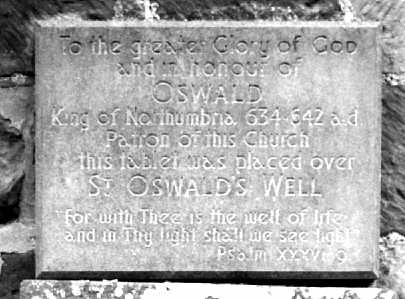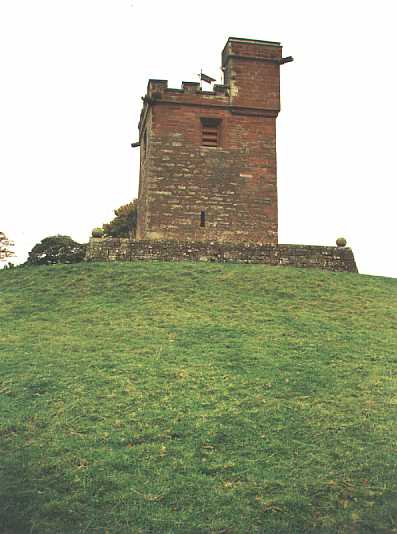 Kirkoswald is an ancient,
irregularly-built market town, on a "fruitful and romantically pleasing spot,"
on the declivity of a steep hill, near the river Eden, eight miles N.N.E. of Penrith,
fifteen miles S.E. by S. of Carlisle, fifteen miles S. of Brampton, and thirteen miles W.
by S. of Alston. The ancient market, granted in the 2nd of John, is held on Thursday, and
a corn market on Monday was established some years ago, but each of them is nearly
obsolete. There is a fair held here on St. Oswald's day, the 15th of August. On
the Raven Beck, which runs through the town, are three corn mills, a paper mill, and a
mill for carding and spinning wool.
Kirkoswald is an ancient,
irregularly-built market town, on a "fruitful and romantically pleasing spot,"
on the declivity of a steep hill, near the river Eden, eight miles N.N.E. of Penrith,
fifteen miles S.E. by S. of Carlisle, fifteen miles S. of Brampton, and thirteen miles W.
by S. of Alston. The ancient market, granted in the 2nd of John, is held on Thursday, and
a corn market on Monday was established some years ago, but each of them is nearly
obsolete. There is a fair held here on St. Oswald's day, the 15th of August. On
the Raven Beck, which runs through the town, are three corn mills, a paper mill, and a
mill for carding and spinning wool.
 As has been already stated, the place
derives its name from St. Oswald, king of Northumberland1, to
whom the parish church is dedicated. Within half a mile of the town, a narrow bridge of
four large and two small arches, built in 1762, crosses the Eden.
As has been already stated, the place
derives its name from St. Oswald, king of Northumberland1, to
whom the parish church is dedicated. Within half a mile of the town, a narrow bridge of
four large and two small arches, built in 1762, crosses the Eden.
The Church stands a short distance from the town
behind a lofty conical hill, on the summit of which is a detached tower, with three bells.
It has lately undergone very extensive repairs, and several stained glass windows have
been introduced. The very highly-finished open roof  of the chancel, and decorative painted
ceiling of the body of the church was executed under the superintendence of Mr. Atkinson,
of Carlisle. About the year 1323, this church was made collegiate for twelve secular
priests, when the present choir is supposed to have been built at the expense of Rowland
Threlkeld, who is said to have been provost of the college. Bishop Nicholson says there
was certainly a church here before the Conquest, and that the saint's name to whom it was
dedicated refers us to the time of the Saxons. In 1305, bishop Halton ordained in this
church seventeen acolites, twenty-five subdeacons, twenty-six deacons, and twenty-one
priests.
of the chancel, and decorative painted
ceiling of the body of the church was executed under the superintendence of Mr. Atkinson,
of Carlisle. About the year 1323, this church was made collegiate for twelve secular
priests, when the present choir is supposed to have been built at the expense of Rowland
Threlkeld, who is said to have been provost of the college. Bishop Nicholson says there
was certainly a church here before the Conquest, and that the saint's name to whom it was
dedicated refers us to the time of the Saxons. In 1305, bishop Halton ordained in this
church seventeen acolites, twenty-five subdeacons, twenty-six deacons, and twenty-one
priests.
"Roland Threlkeld's intention was soon thwarted by the avarice of Henry VIII, who seized on the college about the year 1545; when he also became possessed of the rectory. So far as Henry was concerned, he proved his plea of reformation to be an idle subterfuge for sacrilege; for, by possessing himself of nearly all the endowments of this church, he, in effect, closed the doors against the parishioners, by allowing out of the ample revenues with which the college and rectory were endowed, only £8 per annum, to a vicar: so that probably, in this case as in others, the parish was committed to one unfitted for the office, a menial servant, ignorant, unlettered, it might be vicious."
"So impoverished was the living, that in 1668, George Yates, rector of Croglin, had a license to serve the cure, 'by way of sequestration in the hands of the bishop, it not being worth the expense of a presentation under the great seal: and on that account, only one vicar was appointed to the living for a period of seventy years."*
In 1588, queen Elizabeth granted the possessions of this college to Edw. Downinge and Miles Doddinge. They consisted of the glebe lands, several tenements in the parish, and the tithes of corn and grain; all of which are now the property of Timothy Featherstonhaugh, Esq., except about £5 a year, which is paid to Mrs. Dawson, of Stainton, from Staffield township. The benefice is a vicarage, in the patronage of the crown, and incumbency of the Rev. G. G. Lawson. The vicar's salary consisted only of £8 a year, paid out of the tithes, till 1725, when it was augmented with £800, of which £400 was obtained from queen Anne's bounty, £200 from the countess dowager Gower, and £200 from a subscription. It is now worth about £120 per annum. Timothy Featherstonhaugh is lay impropriator, and the tithes have been commuted for £238 10s., viz., £214. 10s. rectorial, and £24 vicarial. In the town is a Methodist Chapel; and at Parkhead, near the east end of the parish, is an Independent Chapel, which has a burial ground, and which was founded by George Nicholson, a Non-Conformist, in the reign of James II. It was rebuilt in 1711. Near the town are some remains of the ancient castle of Kirkoswald, said to have been "one of the fairest fabrics that eyes looked upon, having a great hall, one hundred yards long, ornamented with pictures of all the kings of England from Brute2, which were removed thence to Naworth castle." Here were anciently seated the lords of Burgh, and the knightly family of Morvil, from whom the manor of Kirkoswald passed to the Multons, and from them to the Dacres, whose co-heiress sold it to an ancestor of Sir George Musgrave, Bart, the present lord of the manor, and lord paramount of the other inferior manors in this parish, for which he holds a court at Kirkoswald, yearly. "Part of the demesne lands are the property of Timothy Featherstonhaugh, Esq., who resides in a neat mansion, called the college, from the estate which formerly belonged to the collegiate church. The Fetherstonhaughs have been settled here since the close of the sixteenth century, and are a branch of the ancient family who were long resident at Featherstone Castle, in Northumberland. Many of them distinguished themselves in the field; Sir Timothy was beheaded in 1651, by Cromwell's party; his two sons were slain at the battle of Worcester; and his relict was plundered by the parliamentarian soldiers to the amount of £10,000."
Staffield, or Staffold is a scattered village, 1½ north of Kirkoswald containing 5500 acres, and about 270 inhabitants. "Within its township are, the hamlets and estates of Scarramanick3, Haresceugh, and Little Croglin. The Staffield estate was anciently held by a family of its own name, but now belongs to Sir H. R. Vane, Bart. Haresceugh was part of the possessions of Lanercost priory, but it was sold after the dissolution to Peter Barwick, physician in ordinary to Charles II. Little Croglin was held by the Beauchamps till the reign of Henry VII, when it was sold to lord Dacre, who annexed it to the seigniority of Kirkoswald."
* Jefferson
Mannix & Whellan, History, Gazetteer and Directory of Cumberland, 1847